There might be affiliate links on this page, which means we get a small commission of anything you buy. As an Amazon Associate we earn from qualifying purchases. Please do your own research before making any online purchase.
The following is a sample from my book Level Up Your Day: How to Maximize the 6 Essential Areas of Your Daily Routine. If you want to improve your productivity, the following strategies can help you do just that and get more out of your working hours. Be sure to check out the book to learn how to be more intentional with how you spend your time.
The work environment (regardless of whether you are at work or home) is filled with “noise” that can distract you from focusing on important tasks.
That’s why it’s important to take a proactive approach and arrange your workspace in a way that helps you clear your mind enough to do your best work.
Here are nine strategies for getting started:
Strategy #1: Kill the monkey
We’ve talked about the dreaded “monkey mind” throughout this book. This is a dangerous mindset where you let the thoughts in your head negatively impact the task you’re currently working on.
The best way to kill monkey mind is to jot down the thought on a piece of paper (even on your to-do list), then explore the idea when you’re not focused on a specific task.
Part of the reason we recommend the Pomodoro Technique is that it forces you to focus on a task and ignore all distractions. If you strictly adhere to this concept, you don’t “count” a task if you break concentration and do something else. The idea here is to teach you the discipline necessary to kill the monkey that often pops into your head.
Strategy #2: Close out email.
Email that is open all the time is too tempting. Even if you don’t respond to email as it comes in, the pinging notifications are often distracting enough to weaken your resolve and break your focus. Master your email by designating specific times for it; otherwise, it will master you.
For instance, Steve schedules “inbox time” for the end of each workday, long after he’s completed his high-energy-level tasks. Furthermore, he has disabled all email notifications on both his email and cellphone. That way, he can only look at email when he’s ready to take action on each message.
Strategy #3: Find the right noise levels.
Some people need absolute silence, while others need white noise to block out distracting sounds in their environment. It all depends on what works best for you.
If you like to listen to music, experiment with different styles until you find one that helps you be more productive with each type of task. Steve prefers classical and relaxing music while writing, but he needs upbeat music when he’s working on mundane tasks.
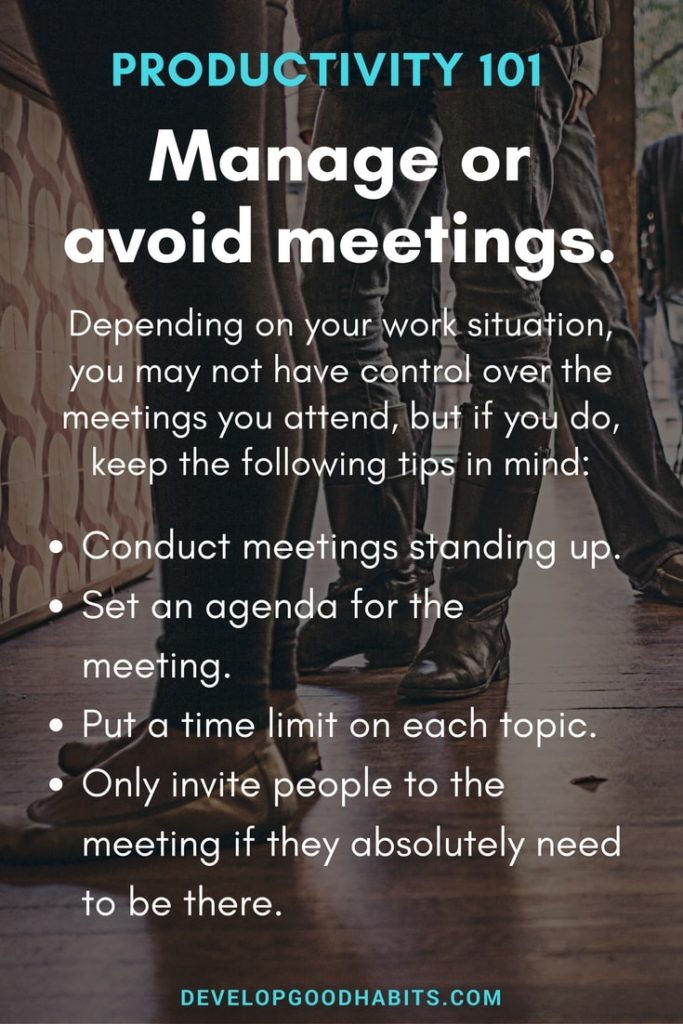
Strategy #4: Manage (or avoid) meetings.
Depending on your work situation, you may not have control over the meetings you attend, but if you do, keep the following tips in mind:
Most meetings are an incredible waste of time and human resources. We suggest that you avoid meetings when you can or look for ways to streamline the entire process.
Strategy #5: Avoid multitasking.
You may feel you get more done when multitasking, but countless studies have proven that people’s productivity diminishes when they engage in this activity.
In fact, multitasking reduces creativity, causes a higher ratio of mistakes, and makes it harder to remember important details. We recommend that you work on one activity at a time and nothing else.
Strategy #6: Know how to deal with interruptions.
You don’t always have as much control over your day as you’d like. Your workday often becomes a series of interruptions, making it impossible to stay productive because you constantly have to deal with them.
Interruptions range from minor irritations (such as an unexpected phone call) to major problems (e.g., illness or the death of a family member). They also include major life changes such as getting married, giving birth, or making a job change.
When these interruptions happen, it’s easy to fall out of your routine. Whether you fail to complete your tasks for one day or drop your entire exercise routine, interruptions definitely make it difficult to stay on track.
We all encounter interruptions, but what separates successful people from everyone else is knowing how to handle them when they occur.
Here are a few ways to do this:
We all have interruptions. The important thing is to understand that they happen and to have a plan for when they occur.
Strategy #7: Learn to say no.
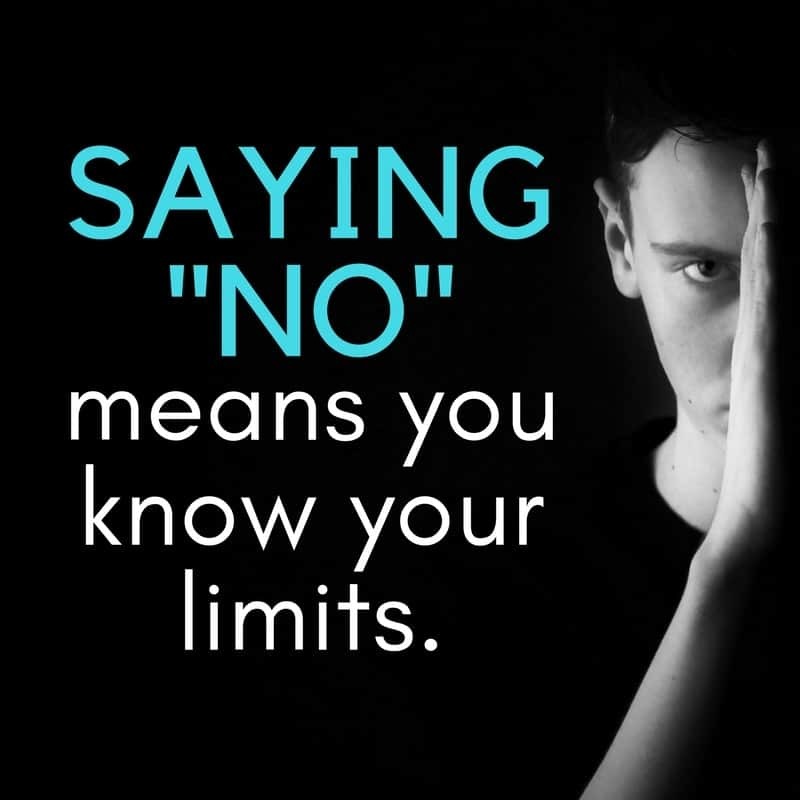
People often say yes when they should say no. There are many reasons why we do this—like not wanting to disappoint someone. But saying yes to everything puts a huge strain on your time and productivity. Do this enough, and it’ll kill the success of your daily routine.
Just remember this: Whenever you say “yes” to a request, you say “no” to something else in your life.
Of course, there might be some people you feel you can’t say no to, such as a boss. If that’s the case, practice the “yes, but” method.
For example, you can say, “Yes, I’d be happy to do [requested item], but that will put me behind on [another important item]. Would you prefer that I do [requested item] first, or would it be better for me to focus on [the other important item] instead?”
Keep in mind that saying no isn’t rude, and there are many ways to say no without using the word “no.” For instance, you can say something like, “Thanks so much for considering me for this fantastic opportunity, but I don’t have the bandwidth to do it justice right now.”
That approach affirms the person and opportunity without forcing you to give in to a request that isn’t right for you.
Strategy #8: Eliminate inefficiencies.
There are many tasks you simply don’t need to do, and it may be possible to minimize others. For instance, a housewife may feel the need to vacuum every day, even if doing so once or twice a week is sufficient.
In other cases, a task needs to be done, but not necessarily by you. Using vacuuming as an example, the mom can perhaps delegate that task to one of her older children.
If you’re a business owner or in a management position, focus on the tasks that can only be done by you and delegate the rest to others.
Other tasks can be automated. For instance, you can set up email filters to automatically delete certain types of emails. A great resource for reducing time spent on computer-based tasks is the “If This, Then That” (IFTT) website. Use this tool to create recipes that streamline many services like Facebook, Evernote, Fitbit, Twitter, and Dropbox. To get started, enter a site/device that you regularly use, and IFTT will provide a number of ideas for automating these processes.
Strategy #9: Use productivity tools.
In addition to IFTT, there are a number of tools you can use to reduce the amount of time you spend in front of a computer.
Rescue Time is a time-management program and productivity tool that monitors what you do on a computer and provides a daily report of your productivity.
Unroll.Me is a simple tool that hunts down all your subscriptions so you can look at them in a single email, unsubscribe from unwanted lists, or ignore the email and keep it “as is.”
Sanebox is a third-party program that works with all email clients. Its purpose is to only allow important messages to show up in your inbox. The rest are sent to a separate folder. Then, at the end of the day (or at a time you specify), it will send you a message that contains everything in the “separate” folder.
Gmail (and other email services) has a tool for creating “canned responses” for common questions. You can use this to decrease the amount of communication you do through email.
If you don’t have Gmail, then TextExpander (for Mac) or FastFox (for PC) can help you quickly craft messages that are common to your particular job.
We currently live in an amazing age with infinite options for streamlining work activities, but you might have to do a little digging to identify the tools that work best for your work style and job responsibilities.
It’s been said that we spend one-third of our time working. Because of this, it’s critical to systematize your day so you get the most important things done first without succumbing to the idea that you need to complete every task on a daily basis.
Productivity tip: Being productive isn’t about getting more time so you can work more. Instead, you should strive to be productive to spend as much time as possible doing what you love and spending time with the people who truly matter.
To quote Senator Paul Tsongas, “Nobody on his deathbed ever said, ‘I wish I had spent more time at the office.”
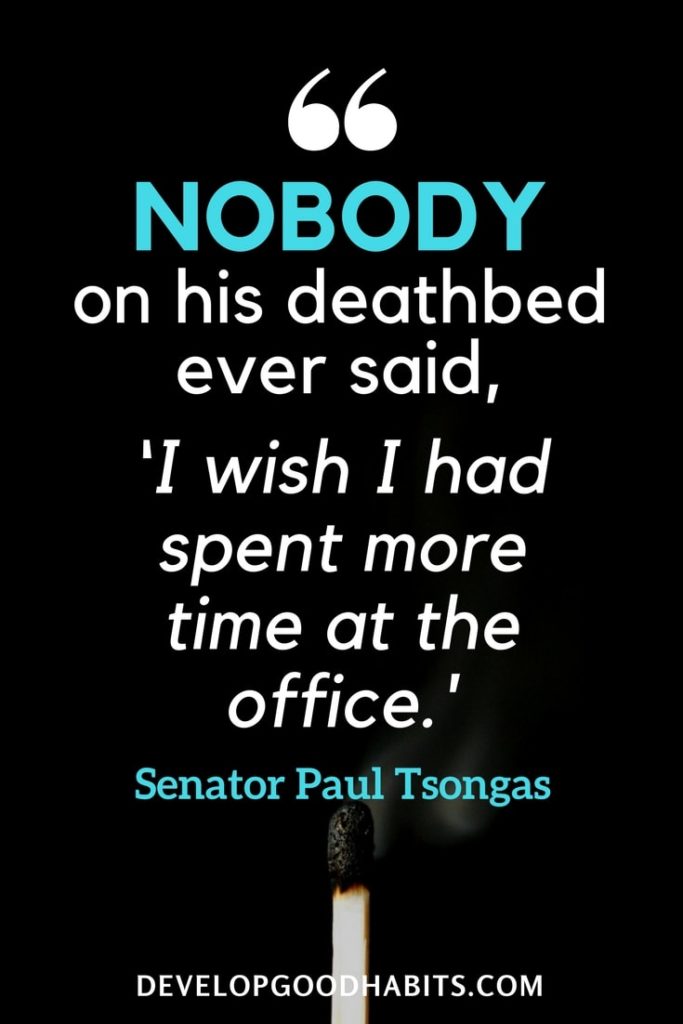
Things to Improve on at Work
If you go by the list above for how to be more productive at work, you will see there are several things you can do to become more productive, manage your time, and improve work efficiency. Here are a few more things to improve on at work that you may want to consider for getting things done.
Limit your distractions.
Did you know it could take around half an hour to refocus once you are distracted at work? Because of workplace distractions, more than 54% of employees do not perform as well as they should. More than half say they are less productive, and approximately 20% of employees admit they cannot reach their full potential or advance in their careers of distractions.
When at work, one must remain focused. To do this, we need to learn what our distractions are to better avoid them. If your phone is a distraction at work, turn it off. If the noise is too much, consider moving to a quieter place or wearing headphones to minimize these distractions. If you do remote work, make sure you have a dedicated home office space you can work in to limit distractions.
Create milestones.
If you are currently working on a big project, it may be overwhelming. If this is the case, you also may welcome any distraction that comes your way. To improve employee productivity, create milestones in the work environment. Breaking up a big project into smaller milestones can improve employee motivation, employee performance, and even employee morale.
Once you have set milestones, you should also allow for a reasonable amount of time to complete each milestone to achieve a more satisfactory outcome at work.
Prioritize your tasks.
How many of us find ourselves constantly multitasking while at work? It is definitely not uncommon, so we included avoiding multitasking as one of our top nine ways to be more productive at work.
If you work for a bigger company or your employer is always busy, you may need to stay on top of several smaller tasks and maintain effective communication in the workplace. To make these smaller tasks easier, prioritize the workload.
If you have several projects at once, prioritize each and work on just one specific task at a time. This allows you to achieve better quality work and your focus remains on one task rather than several at a time.
What About Productivity and Employee Performance?
When it comes to defining employee productivity and performance, there is often a lot of confusion. These terms are used interchangeably, but there are subtle differences between the two we should be aware of.
Employee performance at work
An employee's performance at work comes down to their ability to complete their goals or objectives and includes communication skills, punctuality, and willingness to collaborate and work with others. When you consider employee performance, you also have to look at efficiency.
Employee productivity
A person's work output often measures productivity over time. This includes quality work, the amount of work completed, the amount of hours, and the money invested. Companies are always on the hunt for the best and highest outcome possible when it comes to employee productivity while allowing for minimal input.
More hours do not equate to an increased productivity level. Downtime is not always wasted time, and multitasking doesn't always mean you get more done. These are just a few things we already mentioned needed to be changed to become more productive at work.
To improve work performance and productivity, follow all our tips above. Make sure there is effective team communication and job satisfaction. Also, offer constructive feedback when necessary. That way, employees can use their strengths and work on their weaknesses. Employee engagement and collaboration are also good and result in more productive people, improved job performance, and work efficiency.
Here are a few more ways to be more productive at work:
Finding the Right Work Life Balance
I have spoken a lot about productivity in the workplace, but how exactly do we also maintain the right work life balance in the process?
To strike a better work life balance, manage your time, detach from work, prioritize your health, unplug, and understand that there is no perfect balance.
Finding the right work life balance means equally prioritizing your career and personal life. Increased work responsibilities, longer hours, increased home responsibilities, and children are all factors that can lead to a poor work life balance for many.
Striking a balance can result in less stress, a much lower risk of burnout, and a greater sense of overall wellbeing.
No More Excuses!
Regardless of your situation and the demands on your time, you can carve out time for the things that matter most with a little bit of creativity and careful planning. Use these strategies and start seeing improvement in your productivity.
To learn more and become a more productive person, I encourage you to check out my book Level Up Your Day: How to Maximize the 6 Essential Areas of Your Daily Routine to maximize the effectiveness of your daily routine.
If your productivity depends on your team's effort, here are some good team-building questions to help you improve your working relationships.
To help you stay focused on your goals, read this post about creating SMART goals for your work or job.
Finally, if you want to level up your productivity and time management skills, then watch this free video about the 9 productivity habits you can build at work.
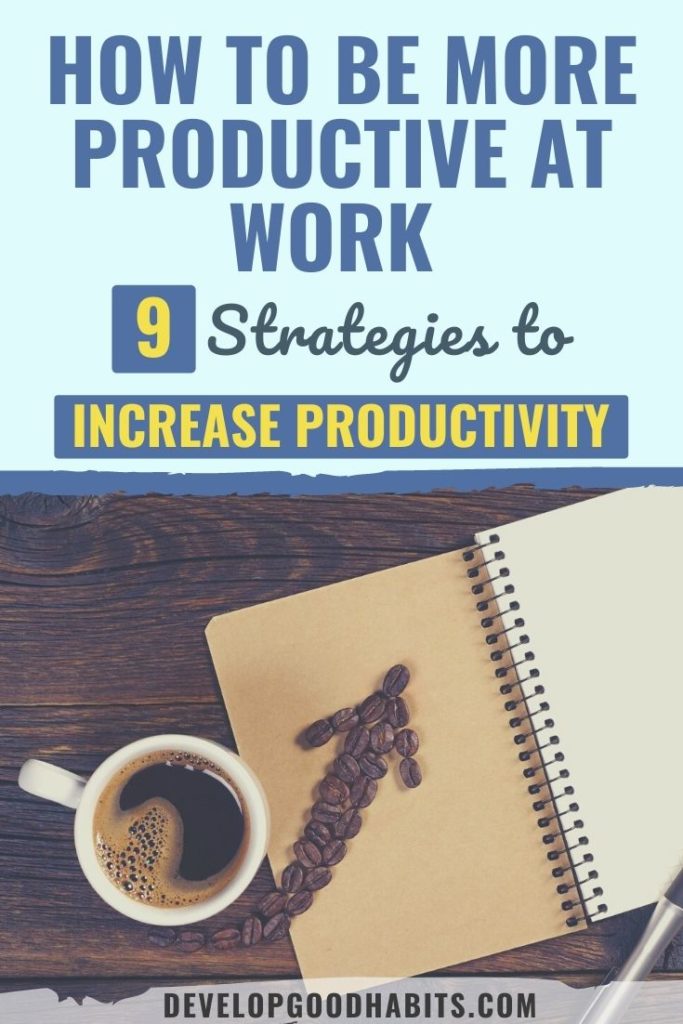

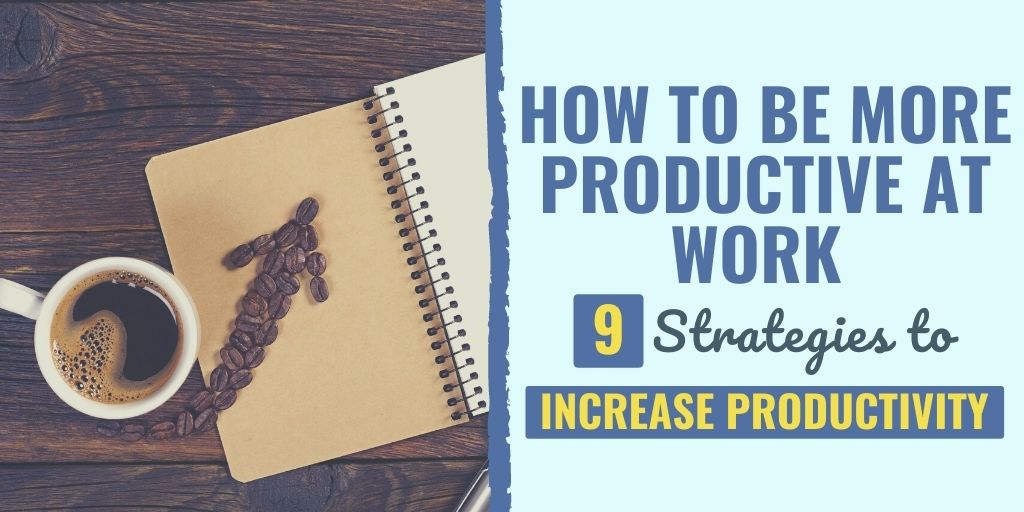
Hi S.J.,
This is such a timely post. I have been having a hard time managing the tasks I have lately. I think the problem is my inability to say no. I spread myself too thin most of the time so from now on, I’ll make sure to prioritize and try saying no for a change.
Thanks for your helpful tips. I look forward to a more productive me through your hacks.
Have a beautiful day!
Luna
My favorite way to be more productive is to do my most important (and often toughest!) thing first. If I spend even 20 minutes tackling something big and meaningful first thing in the morning, the rest of the day tends to go great!
This strategy works great for many of my clients as well.
Ravi Raman
Executive Coach
http://RaviRaman.com
I also do the same. I do all the exhaustive tasks first and keep easy ones for the rest of the day.
“Until the day they die”
I just learnt something new. I learnt how to unsubscribe from 33 newsletters in less than 2 minutes using unroll.me
Thanks Scott
Very enlightening. Our brain is like a muscle that can be trained into a more productive one. Your four methods are spot-on. May I add, “stop multitasking” on your list. If you notice, when we multitask, it slows us down in getting both tasks done. We are easily distracted from one task to the other. So, we need to focus on one task before jumping into the other.
Great Tips. I’d like to share few more tips to improve productivity at workplace:
1. Keeping your desk clean is key to being able to get more work done.
2. Checking emails first thing in the morning can burden you with unnecessary tension. Stop doing it.
3. Studies report that taking regular breaks during the work day can improve productivity.
4. If you see a task or action that you know can be done in two minutes or less, do it immediately.
5. Happiness at work is the #1 productivity booster. Smiling can greatly improve your mood and reduce stress. Even better, your smile doesn’t have to be real, so you can fake it and still get the same results
6. For productivity tools, I’d like to suggest ProofHub here. ProofHub brings a blend of amazing productivity features that teams can use to run their day, their projects and their work-life. Tasks, Online discussions, Group chat, Reports, Gantt Charts, Proofing tool, Calendar, Timer, Timesheets, Quickies and what not; everything you need to bring teams together, collaborate and get projects delivered on time is available within this single tool. https://www.proofhub.com/
When your energy level drops or you are becoming too reactive to others, take time to rejuvenate yourself by taking a break, Thanks for share 🙂
Great tips, thanks for sharing.
Great article! I love how you included the Pomodoro technique. It’s helped me stay on task a TON. I do have one more piece of advice that I think is very important to understand. Effectiveness over efficiency. I learned this from reading the 4-Hour Work Week by Tim Ferriss and have implemented the mindset into my life. I think it’s very true in being that you can be very efficient and still get nothing done. OR quality suffers. Effectiveness, however, is a different story. You can’t really be effective and still get nothing accomplished UNLESS you’re being effective at doing nothing! Which no one means to be effective at doing nothing, so I think it’s a great mindset to adopt. Thanks for sharing your thoughts, SJ! I’ll be tuning in for more content for sure 🙂
Chris, Great addition with the importance of effectiveness! I agree 110%
I’d really like to hear out which studies said multitasking is bad. As I have many examples of people sitting in the conferences/meetings listening to the idea pitch on the one ear and with another eye texting his future wife. There more examples and most of them are wise and has a good leading roles in companies.
I liked another bullet of your list! Using productivity tools, pomodo techniques, even simple watch helps a lot. I learned a lot about these productivity techniques in BitDegree course and it boosted my focus, now I’m more productive and able to concentrate on a long-term things!
There have been hundreds of studies on ther negative effects of multitasking. Here is a brief of one experiment I found in a few seconds looking on Google Scholar: https://www.sciencedirect.com/science/article/pii/S1071581911001431
It is basically the way your brain works. You don’t process in parallel, but in serial, so when you multitask you jump nearly instantaneously from topic to topic. And every jump equals a TINY bit of loss.
The only GOOD multitasking is when it takes zero processing power. Like listening to music or books on tape while running. Multitasks that work with synergy rather than challenging your brain for real estate.